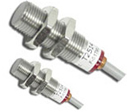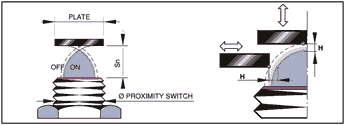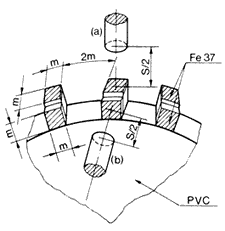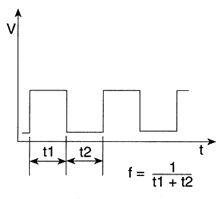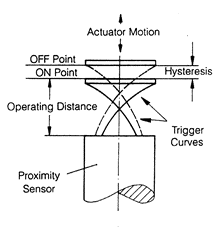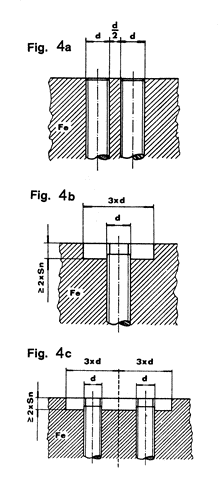|
Definitions:
NO
(normally open): A switch output that is open prohibiting
current flow when an actuator is not present and closes allowing
current flow when an actuator is present.
NC
(normally closed): A switch output that is closed allowing
current flow when no actuator is present and opens prohibiting
current flow when an actuator is present.
NPN
Output: Transistor output that switches the common or
negative voltage to the load. The load is connected between
the positive supply and the output. Current flows from the
load through the output to ground when the switch output is
on. Also known as current sinking or negative switching.
PNP
Output: Transistor output that switches the positive voltage
to the load. The load is connected between output and common.
Current flows from the device's output, through the load to
ground when the switch output is on. Also known as current
sourcing or positive switching.
Operating
Distance (Sn): The maximum distance from the sensor to
a square piece of Iron (Fe 37), 1mm thick with side's = to
the diameter of the sensing face, that will trigger a change
in the output of the sensor. Distance will decrease for other
materials and shapes. Tests are performed at 20ºC with
a constant voltage supply. This distance does include a ±
10% manufacturing tolerance.
Power
Supply: The supply voltage range that sensor will operate
at.
Max
Switching Current: The amount of continuous current allowed
to flow through the sensor without causing damage to the sensor.
It is given as a maximum value.
Min
Switching Current: It is the minimum current value, which
should flow through the sensor in order to guarantee operation.
Max
Peak Current: The Max peak current indicates the maximum
current value that the sensor can bear in a limited period
of time.
Residual
Current: The current, which flows through the sensor when
it is in the open state.
Power
Drain: The amount of current required to operate a sensor.
Voltage
Drop: The voltage drop across a sensor when driving the
maximum load.
Short
Circuit Protection: Protection against damage to a sensor
if the load becomes shorted.
Operating
Frequency: The maximum number of on/off cycles that the
device is capable of in one second. According to EN 50010,
this parameter is measured by the dynamic method shown in
fig. 1 with the sensor in position (a) and (b). S is the operating
distance and m is the diameter of the sensor. The frequency
is given by the formula in fig. 2.
Repeatability
(%Sn): The variation between any values of operating distance
measured in an 8 hour period at a temperature between is 15ºC
-30ºC and a supply voltage with a <= 5% deviation.
Hysteresis
(%Sn): The distance between the "switching on" point of
the actuator approach and the "switching off" point of the
actuator retreat. This distance reduces false triggering.
Its value is given as a percent of the operating distance
or a distance. See Fig. 3
Flush
Mounting: For side by side mounting of flush mount models
refer to Fig. 4a. Non-flush mount models can be embedded in
metal according to Fig. 4b. for side by side refer to fig.
4c. Sn = operating distance.
Protection
Degree: Enclosure degree of protection according to IEC
(International Electrotechnical Commission) is as follows:
IP 65: Dust tight. Protection against water jets.
IP 67: Dust tight. Protection against the effects of immersion
|





